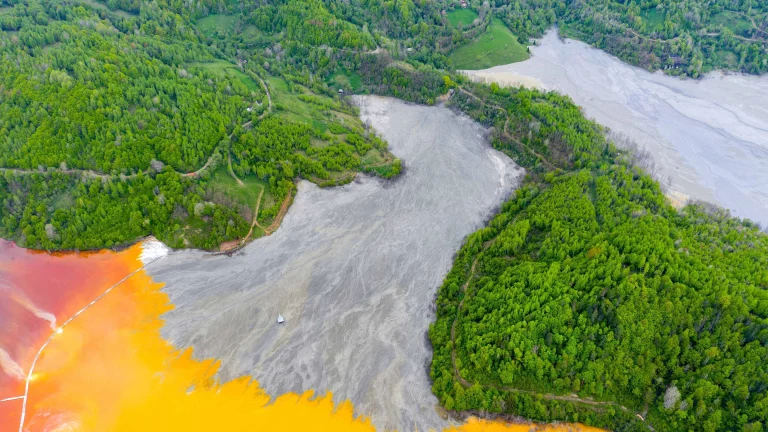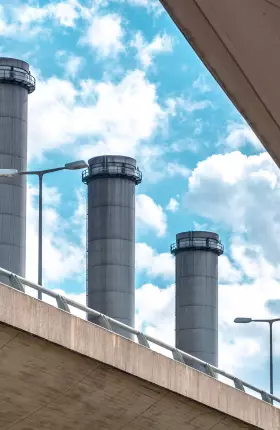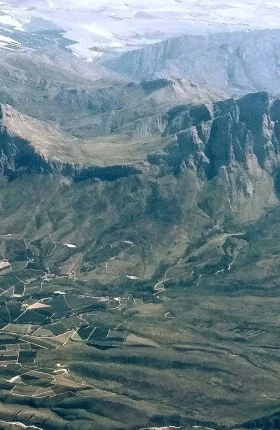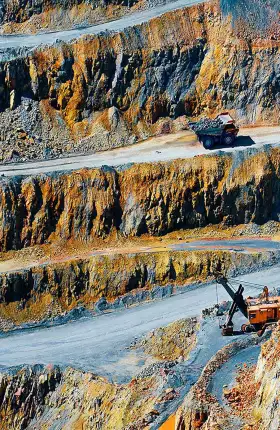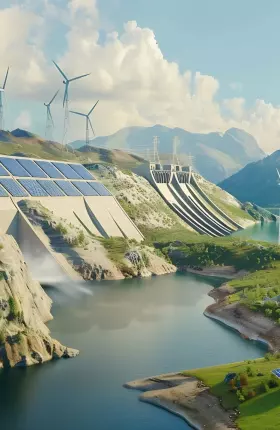South African mining is facing increased pressure to address its environmental impact and carbon footprint, with roughly ZAR 264 billion annually in mining sales at risk from trade partners’ carbon-reduction commitments and reduced local demand. The trade risk from carbon-intensive mining in South Africa and the country’s vulnerability to climate-related events create a unique set of risks but also potential opportunities for mining companies. While individual mining companies are aware of the risks that climate change poses for the industry, and steps are being taken to address the environmental impact of operations, a more collective and targeted strategy is needed to address climate change disruptions. An opportunity exists for South African mining companies to manage the key climate challenges by adapting their operations, adjusting their portfolios, and climate-proofing their businesses to take advantage of the opportunities present in both the near and long term. It is increasingly critical that mining companies move quickly and collectively to manage climate risk. Without action, the industry may end up paying a higher price.
Key Challenges Facing South African Mining
Trade risk
South Africa ranks in the top 20 of most carbon-intensive global economies on an emissions-per-GDP basis. Indirect electricity-use-related emissions (Scope 2) make up the bulk (~77%) of total Scope 1 and Scope 2 emissions in the mining sector. Scope 2 emissions in mining in South Africa are high and more than six times the Scope 2 emissions of international peers. This is driven by the high carbon-intensity of grid electricity and the complex operational context (e.g., deeper mining), which results in relatively high electricity demand by miners. The South African economy will face mounting trade pressure as key trade partners implement low-carbon commitments. Seven of South Africa’s key export markets have all set net-zero targets, including the EU, China, the United States, the United Kingdom, Japan, and South Korea. It is essential to consider how South Africa’s competitiveness in global markets will be affected if key trading partners take steps to protect their net-zero commitments and enable their net-zero carbon growth trajectories.
Reduced demand
Two of the four most significant minerals in South Africa’s commodity footprint are at risk of reduced demand in the future: thermal coal and platinum group metals (PGM—platinum, palladium, rhodium). In terms of sales volume, thermal coal and PGMs are the largest mining sectors in South Africa, accounting for ~50% of total sales in mining—with coal accounting for ZAR 139 billion and PGMs for ZAR 125 billion of total sales volume in 2019. Coal and PGM mining also account for the largest share of jobs. Thermal coal will continue to be required in the near term, but pressure to phase out coal will increase globally in the next 10 to 15 years. The long-term demand for PGMs is uncertain, with production projected to decline by ~10% by 2035 but demand likely to stabilize as PGM use in fuel cells increases.
The uptake of clean-energy technologies (e.g., electric vehicles, renewable-energy technologies, etc.) will become major drivers of new demand and shift value pools in commodity markets to other commodities such as lithium, nickel, and manganese. South African mining companies will need to assess the risks the commodities in their portfolios face and ascertain whether adjustments are required to tap into shifting value pools and mine the minerals needed in the future.
Local climate change impacts
South Africa is a semi-arid country, and a global average temperature increase of 1.5°C translates to a 3°C increase in Southern Africa. Models show this could lead to more variability in rainfall and an increased risk of extreme weather events. Mining companies will need to adapt to these physical changes in their operating environments and along the value chain. Mining infrastructure is vulnerable to physical risks from climate change. Water shortages would increase CAPEX and increase the risk of stranded mining assets as well as interruptions in operations due to water shortages. Building resilience against the physical risk of local climate change will be critical for local mining players.
How South Africa’s Miners Can Address Climate Change Challenges
Despite the challenges climate change presents to South African mining companies, mining companies can respond now to be more resilient in the future. The typical response to climate change among mining companies has been to enhance energy efficiency, secure water sources, and restructure portfolios to exit commodities (most notably coal) that negatively impact the environment. But companies that go beyond this typical climate risk response can build an uncertainty advantage. Instead of merely reacting to uncertainty, companies can use uncertainty to their advantage and climate-proof their operations by tracking the risks, improving their international competitiveness, crafting the right strategic responses, and strengthening their agility and resilience.
To build an uncertainty advantage around climate change risk, mining executives should focus on two key priorities: developing a climate-conscious, scenario-based business strategy and climate-proofing their operations. Evidence suggests that the marketplace will reward those that do. According to BCG’s Smart Multiple analysis, mining companies that have been early movers in addressing climate change—that is, those in the top quintile of emissions-reduction performance—have valuations that are, on average, 20% greater than those of their peers in the bottom quintile.
Climate-conscious business strategy
The true impact of climate change is far from certain. As such, companies’ climate-conscious, scenario-based strategy needs to be adaptable to a range of possible scenarios. In structuring their approach, mining company executives should consider the following questions:
- How will climate change affect demand, supply, and implied pricing for various commodities?
- What specific impact will those changes have on my company’s business?
- Which innovations or new material offerings might benefit our customers, and how can we turn those into new business opportunities?
By running scenarios and simulations, mining companies can gauge the various implications for the company’s portfolio and build effective response strategies both for the near term and looking further into the future. The more diverse their options for rebalancing their portfolios and minimizing negative exposure the better.
Some industry leaders have been adept at scanning the market and tracking indicators (e.g., reduced their coal exposure early), while others have gained from a shift in value pools by shifting production and investing in exploration for mining commodities that will be increasingly in demand (e.g., lithium and manganese). However, radical changes are not necessary across the board. Thermal coal will in the near term still be required globally, and the demand for PGMs is likely to stabilize with decreased volumes from Russia and increased demand driven by fuel cells and other green technologies. There are tailwinds that are promising, and mining companies whose strategies and scenario planning account for a diversity of outcomes are more likely to succeed in the future.
Climate-proofing operations
By their nature, mining activities are resource-intensive and often (particularly in South Africa) located in regions that are vulnerable to climate change. To climate-proof operations, mining companies need to run future scenarios to gauge the possible implications. The more diverse the response options, the better they can craft strategies for managing the impact of climate change on their operations, which vary considerably across commodities, geographical locations, and mining techniques, among other factors. Mining company executives must therefore ask themselves three key questions:
- How can we reduce our direct and indirect carbon emissions footprint?
- How can we modernize operations to ensure operational resilience to the effects of climate change (for example, water scarcity)?
- How can we make climate issues integral to our business decisions and structure incentives and rewards to drive those decisions?
For South African mining companies, reducing Scope 2 emissions (electricity, heat, and steam from third-party suppliers) will be vital to any emissions-reduction program as ~77% of Scope 1 and 2 emissions in South African mining are from the electricity supply. Deploying renewable energy would lead to cumulative 2020–50 emissions savings of between 197 Mt CO₂e (29%) for a hybrid (renewable and grid) supply system and 466 Mt CO₂e (67%) for a fully off-grid supply.
Given the existing electricity tariff structure and the increase of the self-generation cap to 100MW, a promising business case emerges to move toward a hybrid or an off-grid supply (Figure 3). The hybrid supply would be the least expensive option over the 2020–50 period. The cost savings for the hybrid option will depend on how grid tariffs evolve in the future. An increase of the current tariff from ~ZAR 1/kWh to ~ZAR 1.68/kWh (68% increase) would make the off-grid supply concept cheaper than the hybrid option. Mining companies in South Africa have announced renewable generation totaling ~6GW, indicating that the industry sees both the cost and environmental benefits of a self-generation strategy.
Going Forward
In the 2020s, mining companies will need to choose a bold path. Given the reality of climate change and its escalating costs, mining companies should be acting now to:
- Establish a dedicated activist Program Management Office (PMO) to manage emission reduction programs and other ESG initiatives
- Secure the necessary digital and ESG talent as well as upskill existing employees to meet future needs
- Build an ecosystem that enables change by partnering with regulators, local communities, and employee organizations
Mining companies should approach their emission reduction programs with the mindset of a holistic business transformation and put in place a dedicated activist PMO. To establish the initial baseline BCG’s Co2.AI can be leveraged to develop an activity-based product-level emissions baseline that targets and milestones will be based upon. Mining companies should be assessing a range of reduction measures including assessing their technology options and the cost and feasibility of the various options. Whichever emissions reduction strategy is chosen, it must be implemented with the same rigor and commitment as a traditional holistic business transformation.
Understanding which reduction levers to use, how to apply them, and in what sequence is no simple task and requires specialized talent. Setting up dedicated centers of expertise and modernizing operations by introducing digital technology to collect and analyze data in a structured manner across all the company’s assets can help assess carbon abatement potential and costs. To implement these modernization initiatives, digital talent will need to be secured.
Additionally, ESG initiatives will require securing talent with ESG knowledge and competencies as well as reskilling existing employees to meet these challenges. In a recent BCG survey, a lack of ESG knowledge and competencies was found to be the key constraint hindering sustainability being embedded in an organization’s corporate strategy. With the high demand for digital and ESG talent across South Africa, mining companies will likely need to set up their own digital accelerators and train the next generation of talent rather than relying on the external market.
South African mining companies should remember that their climate response will need to be coordinated across the industry and with the support of regulators and stakeholders, including employees and local communities. Implementing measures to address climate challenges will require all stakeholders to collaborate diligently and remove any barriers to enable the change needed (e.g., regulators increasing self-generation caps). By working together, the various stakeholders can shape a greener mining industry in South Africa—and one more competitive on the global stage.
